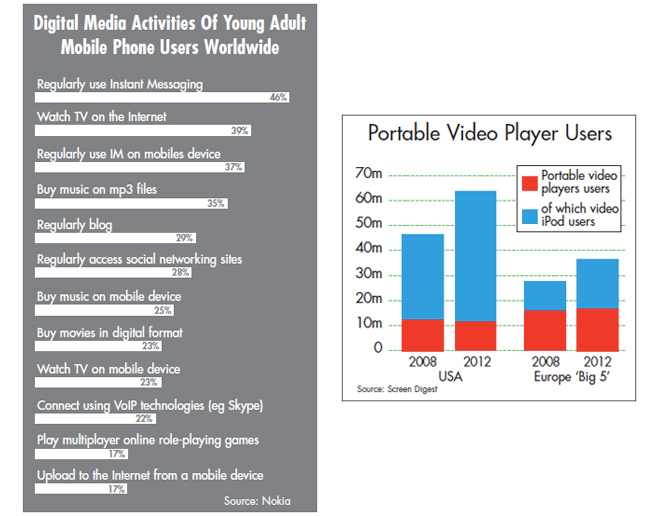Europe's online source of news, data & analysis for professionals involved in packaged media and new delivery technologies

ANALYSIS: Towards a new world order in mobile content
Social networks and mobile applications are putting immense pressure on content owners to quickly roll out mobile content services that provide affordable and exhaustive content selections over-the-air. Screen Digest’s JULIEN THEYS analyses the challenges.
Mobile content has long been touted as an important opportunity for both rights holders and operators. Rights holders saw it as an additional window of exploitation and revenue source, while operators believed content would drive the adoption of high speed 3G handsets and therefore speed-up the returns on their costly investments in 3G infrastructure.
Over the last 24 months, new handsets featuring large touch screens and 3G connectivity made a resounding entry in the mainstream market. Over-the-air video consumption would then be an obvious winner in this new era of constant multimedia connectivity.
Nonetheless, Screen Digest expressed early on concerns about the viability of mobile networks for delivering long-form media-rich content. We believed (and still do) that ‘sideloading’ downloaded content from the personal computer to the handset would prevail because of the quality requirements (resolution, frame rate, file sizes and network coverage).
Short-form video and single tracks are, after all, better suited to the way most mobile owners consumer content (commuting, 'boredom busting').
Over the past 12 months, however, the mobile landscape has been transformed by a series of redefining trends that cast a cloud over the potential for mobile content delivery in its entirety.
Content consumption vs. contribution
While mobile TV infrastructures were once again delayed globally due to a lack of frequencies and disagreements over which business models to adopt, mobile users chose to see their handsets rather as a contribution tool.
For example, the iPhone is now among the most popular cameras used to submit content on popular photo-sharing destination Flickr. Meanwhile, the number of mobile Facebook users worldwide grew from 5m to 15m between January and November 2008.
Social networks and user-generated content sites offer less obvious revenue models than professional content. Their rise in importance significantly and negatively affects the time available to consume content.
Tearing down the garden walls
Since 2007 mobile operators have been testing paid access to mobile versions of popular online social networks. Early that year Cingular (now AT&T) offered access to MySpace for $2.99 a month (excluding data charges). A comparable service was offered by Rogers Canada for C$5 a month. In September of the same year, MySpace launched a free mobile site following pressure from newcomer Facebook, a network which has always favoured the 'free model for mobile. At the same time, competition between mobile operators pushing flat-rate mobile data plans started to heat up and social networks became a key selling point.
The emergence of flat-rate data plans made content easier to access outside operators' portals and resulted in mobile versions of the popular online social networks becoming free like their online counterparts.
In a context where data is unlimited, end users no longer need to worry about excessive data charges, and over-the-air distribution of all types of content can improve. Mobile content therefore becomes more accessible and has the potential to open up new revenue streams – if it can find the right formula.
Slings and arrows
In May 2009, Sling Media launched an iPhone application that allows users to stream content (including TV shows and movies) stored from their home-installed Sling boxes directly to their phones, as is possible on platforms such as Blackberries. However, the iPhone application prevents content to be accessed from 3G networks and only works via Wi-Fi, unlike other platforms where 3G video streaming is enabled.
The move sparked considerable customer anger, especially given the relatively high price of the iPhone application ($30). AT&T had to issue a statement explaining the volume of data required for streaming video to an important number of devices could cripple the network, and went as far as openly categorising the iPhone as a personal computer, therefore excluding it from 3G video streaming.
Beside the worrying aspect of networks such as AT&T under threat by a device that does exatly what 3G was meant for in the first place, the last argument comparing iPhones to PCs seems weaker since there is no such restriction for other Sling-enabled smartphones. There might therefore be another reason in that the iPhone has a critical mass that forces mobile operators to reconsider their 'open' off-portal strategies as soon as usage goes beyond the marginal and could seriously threaten competing, house-bred offers (AT&T does provide premium mobile TV and Video services).
Mobile movies: if you build it, they will come
…or so thought Motorola in launching a movie download service in July 2008. The service offered a selection of over 40 feature films ranging from £5.99 to £8.99. Movies had to be downloaded onto a PC then sideloaded on the handset. There is some anecdotal evidence which suggests that a well positioned digital content store is a minor motivation to purchase a handset in comparison to appealing device design. The store quietly shut down six months later.
This did not discourage Samsung Mobile, who launched Samsung Movies in March 2009, an online video store selling TV shows and movies. At launch, the store's catalogue contains 500 videos from studios including Warner Bros., Paramount, Universal and Momentum Pictures. A further 500 titles were due to be added to the store by the end of 1Q 09, and Samsung intends to expand the library to 2,000 movies and TV shows by June 2009. Content is available on a download-to-own or digital rental basis. This time, though, content will be watchable on the PC – a fact that should give the trial a better shot at survival than Motorola's previous effort.
Music vs. video is so 2008. 2009 belongs to software
As flat-rate data and off-portal web browsing become the norm, a new race is beginning for content providers. And whilst everyone was waiting for music or video to take off, an unlikely potential killer app for mobile has appeared: software.
It took Apple's app store a mere six months to reach 500 million application downloads; comparatively, it took music over two years to reach the same milestone on iTunes. At this writing, there are now over 50,000 applications available for download, with prices ranging from free to hundreds of dollars.
The impressive success of the app store is also an opportunity for games to make a comeback at the forefront of mobile content. Aided by the novelty of the touch interface and the simplicity of purchase, iPhone games, most of which are casual, enjoy a wide success that is reminiscent of the stunning success of Nintendo’s Wii.
It therefore comes as no surprise that all the major mobile platforms (Symbian, Blackberry, Windows Mobile, Palm) already have or are about to launch their own software delivery platform.
However, the triumph of mobile software should come as a strong warning for 'traditional' content owners for several reasons.
Firstly, software usage such as games, social networking tools or content creation applications will cannibalise the available screen time on mobiles. Of the top 10 free apps of 2008 on Apple's app store, three were games, two were social applications and two were (free) music-related applications.
Secondly, software consumer spend is likely to dent traditional content budgets. Every euro spent on a casual game is less likely to be spent on other content. Mobile applications also appear to resist piracy better than music or video content. Of the top 10 paid apps of 2008 on Apple's app store, six were games and two were 'time killers'. Content applications such as music apps from Pandora and Last.fm, or video apps BBC iPlayer and Ustream favour streaming free content.

iTunes evidence
While it will remain hard to assess the true impact of applications on other forms of mobile content (and digital content in general), it is possible to draw some interesting trends from iTunes as it is the biggest online music store as well as today's biggest mobile application distribution platform.
iTunes publicises music tracks cumulative sales, the growth of music sales has been flattening over the last quarters, despite the growing number of iPod and iPhone users. Music sales seem to belong, with TV shows and films, to the same 'spend pool' and attention scope as mobile applications, as they share iTunes store real estate.
Considering purchasers of higher-end devices (i.e. iPod touch and iPhone) have a higher likelihood to spend on iTunes, applications for said devices directly steal focus from other forms of content. Not only the focus is affected, but the activities pursued with an iPhone will be less likely to be music or video-centric if a plethora of applications, among which games, are at hand.
Some artists such as Nine Inch Nails are acknowledging the trend and exploring ways to push content and interact with fans not only through the music store, but also through a customised application that allows further social interaction.
Towards economics of 'free'
When social networking on mobile is free and highly rewarding for the user, when free music streaming applications reach the top application download spots and when content delivery platforms become highly integrated with the platform developer, the window starts to close in on opportunities for paid business models.
With 'Comes with Music', Nokia has become the first handset manufacturer to trial unlimited music downloads tied to a handset. The flat fee for music is included in the handset price. Screen Digest research shows that for various reasons (older handset models, lack of operator support, unclear proposition), the service is having difficulty finding an audience. Its first true test started this May with a popular handset (5800 XpressMusic), on a saturated market (the UK) and subsidised by a top-tier operator (Orange).
Despite its current shortcomings, however, the Nokia case is a great illustration of the current problem facing mobile content: it is becoming increasingly hard to justify paying for music or video on mobile at all – let alone paying more for it than online.
Having a mobile that functions as both a multimedia and a cheap communication and social interaction tool may perhaps be great news for our information society. It could, however, prove less of a blessing for content owners.
Music and video producers should keep the current mobile state of play in mind when considering content deals. If mobile is not part of an exhaustive and affordable offer, users will turn away from content and produce their own.

Julien Theys is an Analyst at Screen Digest where he focuses on mobile advertising and mobile operating systems as well as venture funding and M&A deals in the mobile industry.
Story filed 24.08.09



















